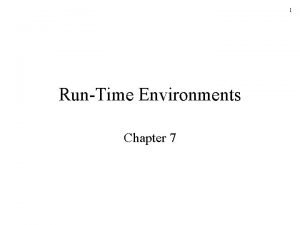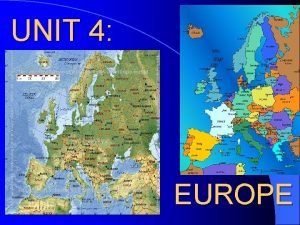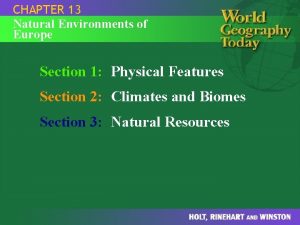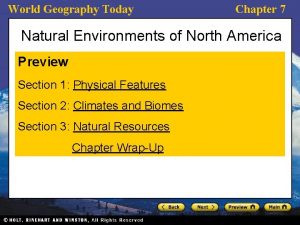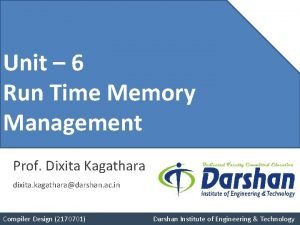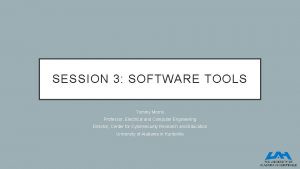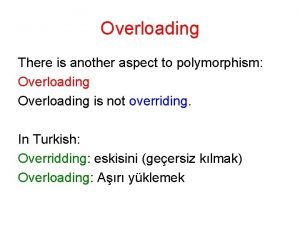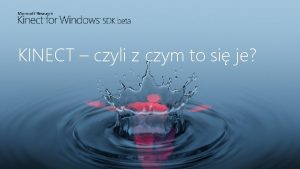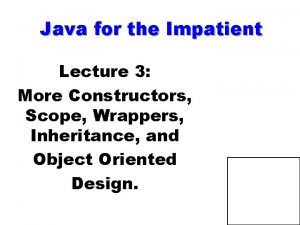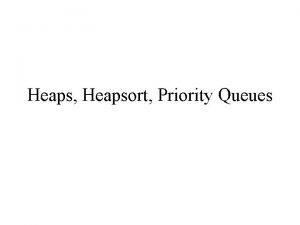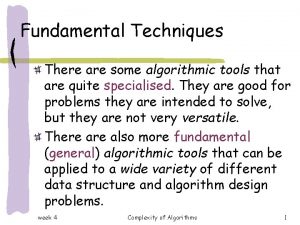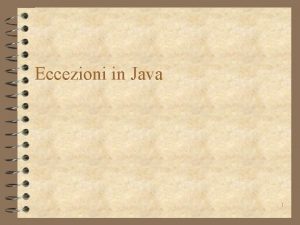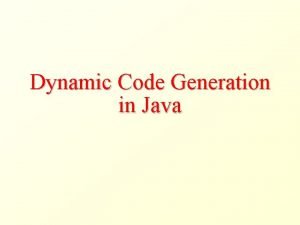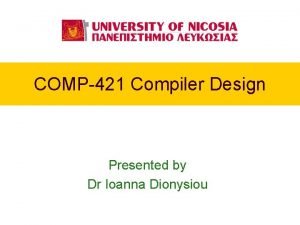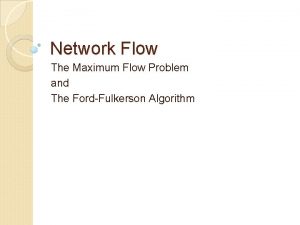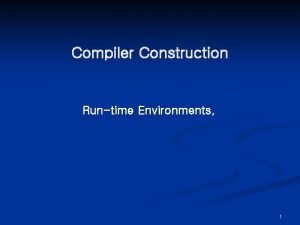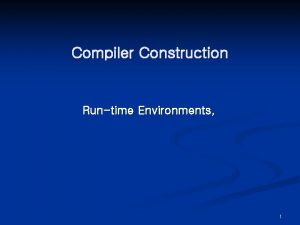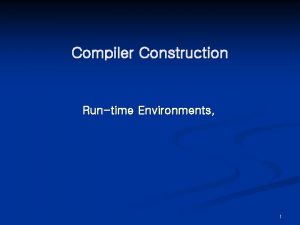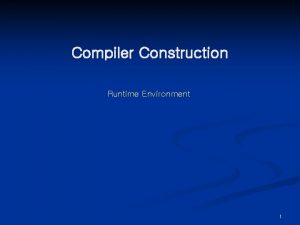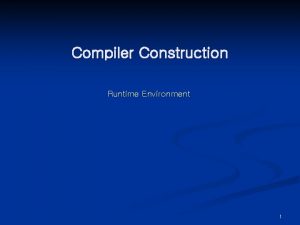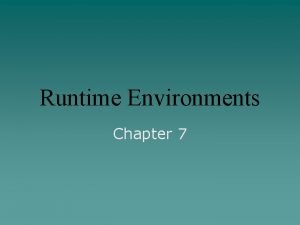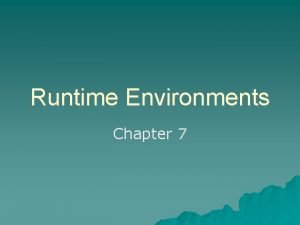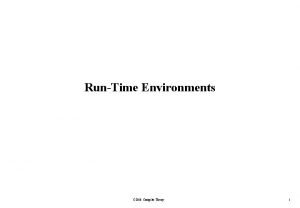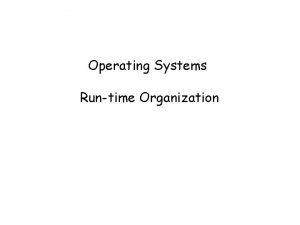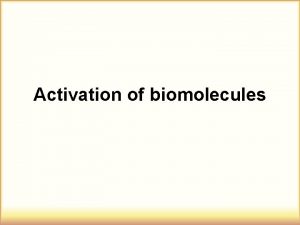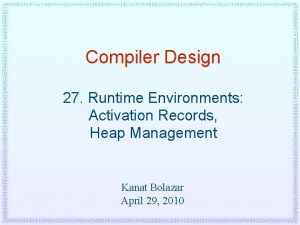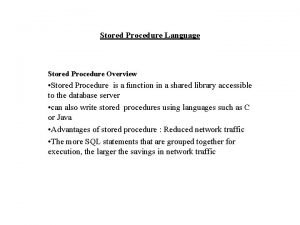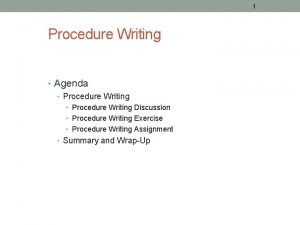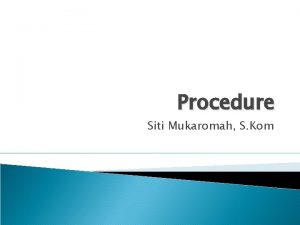1 RunTime Environments Chapter 7 2 Procedure Activation


![3 Procedure Activations: Example program sort(input, output) var a : array [0. . 10] 3 Procedure Activations: Example program sort(input, output) var a : array [0. . 10]](https://slidetodoc.com/presentation_image_h/0601709c6007f23055a23c1d1e87054e/image-3.jpg)












- Slides: 15

1 Run-Time Environments Chapter 7

2 Procedure Activation and Lifetime • A procedure is activated when called • The lifetime of an activation of a procedure is the sequence of steps between the first and last steps in the execution of the procedure body • A procedure is recursive if a new activation can begin before an earlier activation of the same procedure has ended
![3 Procedure Activations Example program sortinput output var a array 0 10 3 Procedure Activations: Example program sort(input, output) var a : array [0. . 10]](https://slidetodoc.com/presentation_image_h/0601709c6007f23055a23c1d1e87054e/image-3.jpg)
3 Procedure Activations: Example program sort(input, output) var a : array [0. . 10] of integer; procedure readarray; var i : integer; begin for i : = 1 to 9 do read(a[i]) end; function partition(y, z : integer) : integer var i, j, x, v : integer; begin … end procedure quicksort(m, n : integer); var i : integer; begin if (n > m) then begin i : = partition(m, n); quicksort(m, i - 1); quicksort(i + 1, n) end; begin a[0] : = -9999; a[10] : = 9999; readarray; quicksort(1, 9) end. Activations: begin sort enter readarray leave readarray enter quicksort(1, 9) enter partition(1, 9) leave partition(1, 9) enter quicksort(1, 3) … leave quicksort(1, 3) enter quicksort(5, 9) … leave quicksort(5, 9) leave quicksort(1, 9) end sort.

4 Activation Trees: Example s r q(1, 9) p(1, 9) q(1, 3) p(1, 3) q(1, 0) q(2, 3) q(5, 9) p(2, 3) q(2, 1) q(3, 3) q(5, 5) q(7, 9) p(7, 9) q(7, 7) q(9, 9) Activation tree for the sort program Note: also referred to as the dynamic call graph

5 Control Stack Activation tree: s r p(1, 9) p(1, 3) q(1, 9) q(1, 3) q(1, 0) q(2, 3) Control stack: s q(1, 9) q(1, 3) q(2, 3) Activations: begin sort enter readarray leave readarray enter quicksort(1, 9) enter partition(1, 9) leave partition(1, 9) enter quicksort(1, 3) enter partition(1, 3) leave partition(1, 3) enter quicksort(1, 0) leave quicksort(1, 0) enter quicksort(2, 3) …

6 Scope Rules • Environment determines name-to-object bindings: which objects are in scope? Variable x locally declared in p A function x program prg; var y : real; function x(a : real) : real; begin … end; procedure p; var x : integer; begin x : = 1; … end; begin y : = x(0. 0); … end.

7 Mapping Names to Values environment name state storage var i; … i : = 0; … i : = i + 1; value

8 Static and Dynamic Notions of Bindings Static Notion Dynamic Notion Definition of a procedure Activations of the procedure Declaration of a name Bindings of the name Scope of a declaration Lifetime of a binding

9 Stack Allocation • Activation records (subroutine frames) on the runtime stack hold the state of a subroutine • Calling sequences are code statements to create activations records on the stack and enter data in them – Caller’s calling sequence enters actual arguments, control link, access link, and saved machine state – Callee’s calling sequence initializes local data – Callee’s return sequence enters return value – Caller’s return sequence removes activation record

10 Activation Records (Subroutine Frames) fp (frame pointer) Returned value Actual parameters Optional control link Optional access link Caller’s responsibility to initialize Save machine status Local data Temporaries Callee’s responsibility to initialize

11 Control Links The control link is the old value of the fp Caller’s activation record fp sp Control link Stack growth Callee’s activation record

12 Scope with Nested Procedures program sort(input, output) var a : array [0. . 10] of integer; x : integer; procedure readarray; var i : integer; begin … end; procedure exchange(i, j : integer); begin x : = a[i]; a[i] : = a[j]; a[j] : = x end; procedure quicksort(m, n : integer); var k, v : integer; function partition(y, z : integer) : integer var i, j : integer; begin … exchange(i, j) … end begin if (n > m) then begin i : = partition(m, n); quicksort(m, i - 1); quicksort(i + 1, n) end; begin … quicksort(1, 9) end.

13 Access Links (Static Links) s s a x a x q(1, 9) access k v q(1, 3) access k v p(1, 3) access i j The access link points to the activation record of the static parent procedure: s is parent of r, e, and q q is parent of p e(1, 3) access

14 Accessing Nonlocal Data • To implement access to nonlocal data a in procedure p, the compiler generates code to traverse np - na access links to reach the activation record where a resides – np is the nesting depth of procedure p – na is the nesting depth of the procedure containing a

15 Parameter Passing Modes • Call-by-value: evaluate actual parameters and enter r-values in activation record • Call-by-reference: enter pointer to the storage of the actual parameter • Copy-restore (aka value-result): evaluate actual parameters and enter r-values, after the call copy rvalues of formal parameters into actuals • Call-by-name: use a form of in-line code expansion (thunk) to evaluate parameters
 Activation tree and activation record
Activation tree and activation record Chapter 13 natural environments of europe
Chapter 13 natural environments of europe Chapter 13 natural environments of europe
Chapter 13 natural environments of europe World geography
World geography Subdivision of runtime memory in compiler design
Subdivision of runtime memory in compiler design System programming definition
System programming definition Scadabr openplc
Scadabr openplc Compile time polymorphism java
Compile time polymorphism java Kinect for windows runtime
Kinect for windows runtime Constructor overloading in java
Constructor overloading in java Heapify runtime
Heapify runtime Matrix multiplication time complexity
Matrix multiplication time complexity Runtime error index out of bounds
Runtime error index out of bounds Dynamic code generation
Dynamic code generation Source language issues in compiler design
Source language issues in compiler design Ford fulkerson runtime
Ford fulkerson runtime
